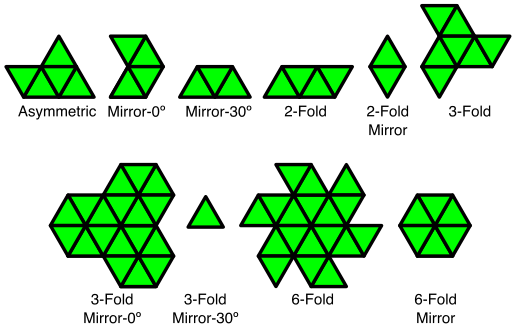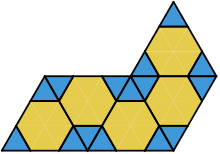Polyiamond
A polyiamond (also polyamond or simply iamond) is a polyform whose base form is an equilateral triangle. The word polyiamond is a back-formation from diamond, because this word is often used to describe the shape of a pair of equilateral triangles placed base to base, and the initial 'di-' looks like a Greek prefix meaning 'two-' (though diamond actually derives from Greek ἀδάμας - also the basis for the word "adamant"). The name was suggested by recreational mathematics writer Thomas H. O'Beirne in New Scientist 1961 number 1, page 164.
| Wikimedia Commons has media related to Polyiamonds. |
Counting
The basic combinatorial question is, How many different polyiamonds exist with a given number of cells? Like polyominoes, polyiamonds may be either free or one-sided. Free polyiamonds are invariant under reflection as well as translation and rotation. One-sided polyiamonds distinguish reflections.
The number of free n-iamonds for n = 1, 2, 3, ... is:
The number of free polyiamonds with holes is given by OEIS: A070764; the number of free polyiamonds without holes is given by OEIS: A070765; the number of fixed polyiamonds is given by OEIS: A001420; the number of one-sided polyiamonds is given by OEIS: A006534.
| Name | Number of forms | Forms | ||||||||||||
|---|---|---|---|---|---|---|---|---|---|---|---|---|---|---|
| Moniamond | 1 |
| ||||||||||||
| Diamond | 1 |
| ||||||||||||
| Triamond | 1 |
| ||||||||||||
| Tetriamond | 3 |
| ||||||||||||
| Pentiamond | 4 |
| ||||||||||||
| Hexiamond | 12 |
| ||||||||||||
Symmetries
Possible symmetries are mirror symmetry, 2-, 3-, and 6-fold rotational symmetry, and each combined with mirror symmetry.
2-fold rotational symmetry with and without mirror symmetry requires at least 2 and 4 triangles, respectively. 6-fold rotational symmetry with and without mirror symmetry requires at least 6 and 18 triangles, respectively. Asymmetry requires at least 5 triangles. 3-fold rotational symmetry without mirror symmetry requires at least 7 triangles.
In the case of only mirror symmetry we can distinguish having the symmetry axis aligned with the grid or rotated 30° (requires at least 4 and 3 triangles, respectively); ditto for 3-fold rotational symmetry, combined with mirror symmetry (requires at least 18 and 1 triangles, respectively).

Generalizations
Like polyominoes, but unlike polyhexes, polyiamonds have three-dimensional counterparts, formed by aggregating tetrahedra. However, polytetrahedra do not tile 3-space in the way polyiamonds can tile 2-space.
Tessellations
Every polyiamond of order 6 or less tiles the plane. All but one of the heptiamonds tile the plane, the exception being the V-heptiamond. [1]
Correspondence with polyhexes

Every polyiamond corresponds to a polyhex, as illustrated at right. Conversely, every polyhex is also a polyiamond, because each hexagonal cell of a polyhex is the union of six adjacent equilateral triangles. (Note, however, that neither correspondence is one-to-one.)
In popular culture
The set of 22 polyiamonds, from order 1 up to order 6, constitutes the shape of the playing pieces in the board game Blokus Trigon, where players attempt to tile a plane with as many polyiamonds as possible, subject to the game rules.
External links
- Weisstein, Eric W. "Polyiamond". MathWorld.
- Polyiamonds at The Poly Pages. Polyiamond tilings.
- VERHEXT — a 1960s puzzle game by Heinz Haber based on hexiamonds (Archived March 3, 2016, at the Wayback Machine)
